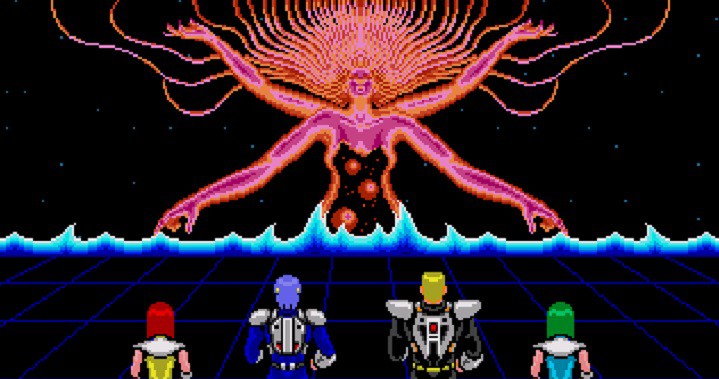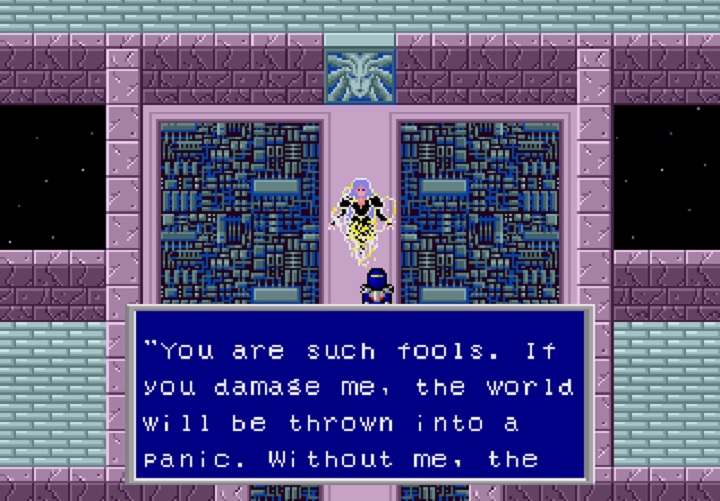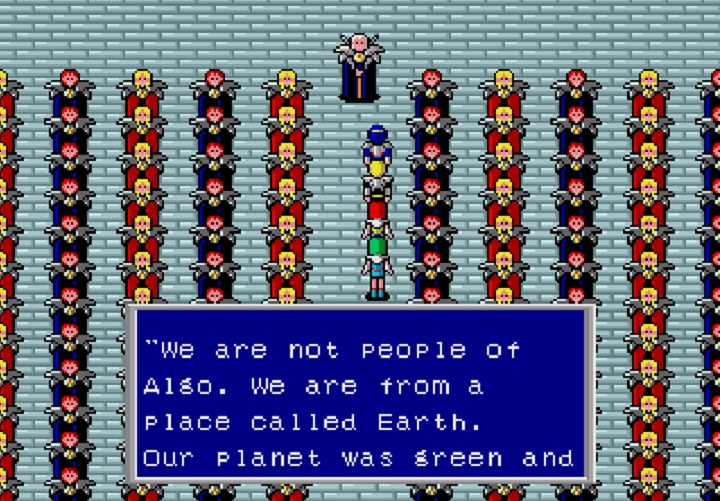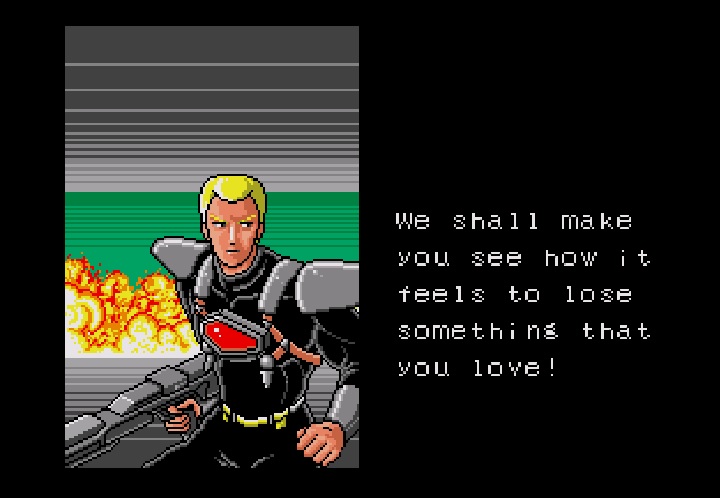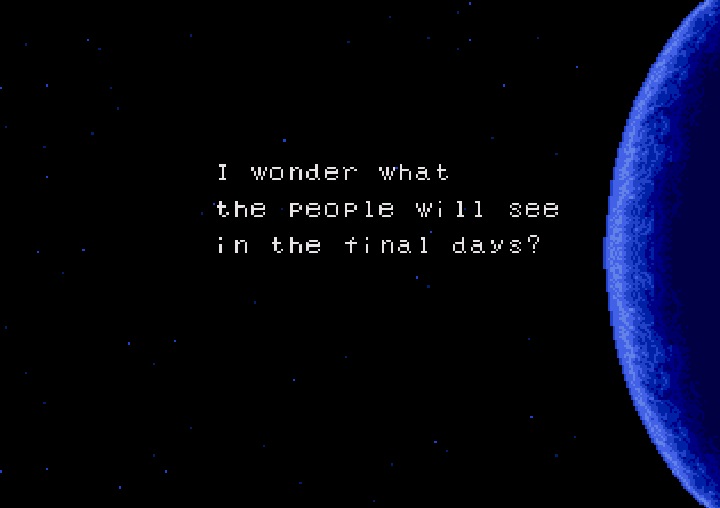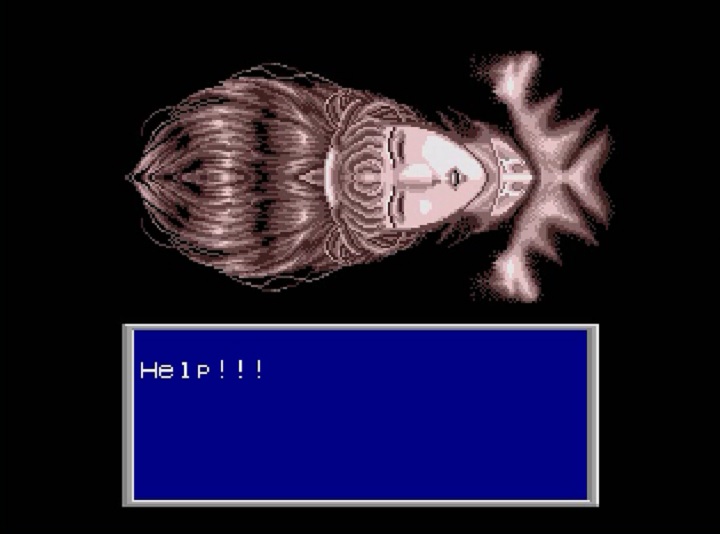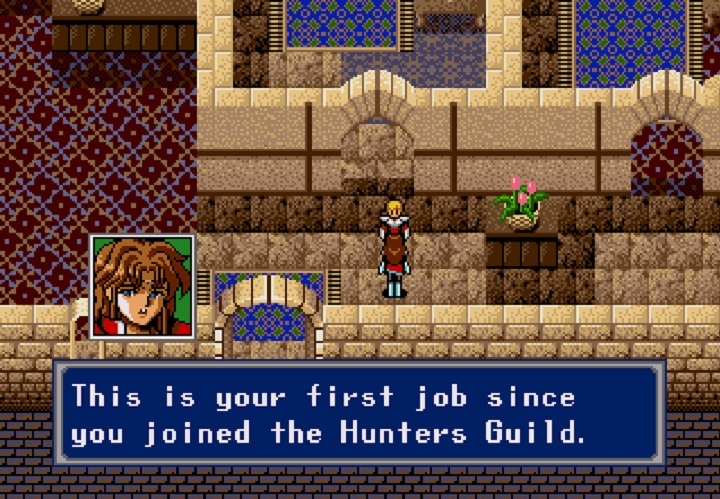I can name so many JRPGs I love, but if you asked me to tell you their endings, I’d honestly struggle to remember. Most of them blend into each other in a huge canvas of predictable outcomes that usually result in the hero saving the world, various party members going back to their respective homes, and the protagonist uniting with their love interest. Phantasy Star II was a trailblazer for having a totally unique experience that left me literally at the edge of my seat. I’d even put it up there with some of the best endings in any medium that includes Use of Weapons, the original Planet of the Apes, and Hitchcock films like Vertigo and Psycho. When it comes to gaming, titles are sparse for truly amazing endings (that includes contemporary games as well). But ask almost anyone who has beaten Phantasy Star II and they’ll be able to recount the final scene back to you in detail.
The Mother of Brains
After you’ve collected all the Nei weapons, Lutz teleports you up to the Noah Space Station. There, you take out Dark Force, fight off legions of foes, and finally confront the Mother Brain. She gives you the option of walking away, asking, in essence, do you want chaos with freedom, or order in exchange for a form of slavery? Destroying Mother Brain ensures the system will go helter skelter. Or as she puts more bluntly, “You are such fools. If you damage me, the world will be thrown into a panic. Without me, the people of Algo are helpless. They have become too soft and used to comfort. If I were to malfunction, the people would die cursing their fate. If that is your aim, disable me! If not, return now!” At this point, you are given a window with a yes/no option.
The battle isn’t difficult—a combination of the explosive technique megid, snow crown, and attacks using the Nei weapons will destroy Mother Brain’s system. Unfortunately, she wasn’t exaggerating about her importance to the world. Her death leads to the complete collapse of the Motavian utopia. Climatrol and the Biolab are no longer under her control and a tough life awaits the citizens.
But before you can leave, Lutz realizes there’s another presence aboard the ship and urges you to go face it. You walk past Mother Brain’s hall into a chamber filled with an eerie choir dressed in a panoply of colors. Their leader, who looks uncannily human, greets you and admits that they were the ones who built Mother Brain. They reveal that they are from a planet called Earth that destroyed itself long ago and they came here to exploit the star system. The ultimate villains are Terrans, and you, the player, a human being, need to defeat them. The truth that despite all the positive ramifications of Mother Brain, humans could be capable of so much evil to the point of committing mass genocide, was startling. Hadn’t Earth already been destroyed by their past greed? What were they hoping to gain?
A battle ensues, punctuated by anime style portraits of each of the characters in their various battle poses side by side with texts of angry defiance. I couldn’t wait to find out how it all concluded. The shot of Rolf resolutely gritting his teeth had me enthralled.
The game cuts away to a view of space and Dezo. A question is posed: “I wonder what people will see in the final days.” A credit sequence follows climaxing in an unexplained flash of light. The End.
I kept on pressing the buttons on my controller to check if I’d missed something. What happened? Did Rolf win? Did the humans triumph? Would they reestablish control with a new Mother Brain? Or did both parties die? Even when the sequel came out, none of those questions were answered as Phantasy Star III was more of a side story than a continuation of the second part. I couldn’t get the ending out of my mind.
Phantasy Star II’s journey could almost be considered a form of existential alienation. The more you progress, the more isolated you become. The utopianism of Mota seems foreign after the death of Nei and the destruction of Parma. But in Dezo, the religious fervor seems even more repulsive. Neither technology nor spirituality provide any succor. Instead, the party treks on, not knowing what awaits after each dungeon is ransacked of its treasures. I thought about my own ambivalence to tackle Mother Brain. I couldn’t say with absolute certainty that destroying her was the right thing to do, even though I knew I had to for the story to proceed. “Hell is other people” takes on a disturbing new context when those other people turn out to be literal humans attempting to subjugate the star system. Combat is the expression of the party’s reflective anxiety. Their consciousness only finds meaning at the edge of a sword as even their humanity offers no comfort.
What’s important in this final act is that Rolf and company no longer fear death. They’ve acquired, in Monomyth terms, the “Freedom to Live.” In contrast to his earlier reluctance to die on Giara and even his subconscious terror of death as reflected in the mythic battle taking place in his dreams every night, Rolf is finally ready to face it directly. As Joseph Campbell puts it: “He does not mistake apparent changelessness in time for the permanence of Being, nor is he fearful of the next moment.” In that sense, the actual results aren’t as important as Rolf coming to terms with his mortality.
Still, I wondered what their eventual fate was.
There used to be a thing called the 16-bit wars where kids would argue whether the Genesis or the SNES was the superior console and go on for weeks about why they were right. My main argument for why Genesis was better came down to Phantasy Star II. There was no JRPG on the SNES in 1990 that compared (it would be another four years before Final Fantasy VI) and the closest thing to a competitor was Final Fantasy IV, which, while a great game, could not compete with the vast space epic of PS2. To those of us who’d played it, we spent hours making up stories about what really happened at the end, speculating, even dreaming of sequels.
The Sequels
It would take the fourth part in the series to continue the legacy of the second. Just by fact that Mother Brain didn’t exist a thousand years later, I assumed the humans had been stopped. Phantasy Star IV is spectacular with gorgeous art and gameplay. It also has a much stronger story with better characterizations than the second one. Still, as much as I loved Phantasy Star IV, there was something gritty in the Motavian paradise of PS2 with its immersive science fiction setting that still makes it my favorite. As for the direct sequel, Phantasy Star III, I loved the concept of having multiple generations carve out their destiny on a space colony formed by those who escaped the destruction of Parma. But it took so many steps back from a visual and story-telling perspective, I feel conflicted about it to this day. It does have arguably the best party member of any 16-bit JRPG, a cyborg named Wren. He can transform into a submersible, aquaswimmer, and my favorite vehicle, the aerojet, that lets you fly all over the map. As much as I cherish Final Fantasy’s airships (I’ll be tackling FF9 soon!), I’d rather take an aerojet any day.
Phantasy Star II also has a series of text adventure games which were downloadable on the Sega Meganet, the 16-bit version of an online store. Each of the adventures explores the background of the main characters, expanding on their personalities and motivations leading up to the events of the game. I haven’t played it, though I’ve watched some of the walkthroughs. I can’t say the narratives were compelling enough for me to want to play them further. That, in addition to a clunky interface and almost no visual feedback on the environments has me reluctant to devote hours to it.
After Phantasy Star IV, the series went 3D and online with Phantasy Star Online. There were lots of interesting elements that made it worth checking out at the time, including its tagline, “You are not the only hero.” But it strayed so far from the original games, I found myself pining for a Phantasy Star game in the spirit of the originals.
That’s because whenever people ask me about my favorite games or even favorite works of fiction in general, I think about that first time I heard the story of Phantasy Star II, then got to actually playing it. That sense of wonder, excitement, despair, bliss, and longing is what I look for in every game I pick up. Even now, I wonder about Rolf and his party, what they thought of as they fought against that army of humans. It was the greatest phantasy of my childhood because it never ended.
Peter Tieryas is the author of United States of Japan (Angry Robot, 2016) and Bald New World (JHP Fiction, 2014). His work has appeared in Electric Literature, Kotaku, Tor.com, and ZYZZYVA. He dreams of utopias at @TieryasXu.










